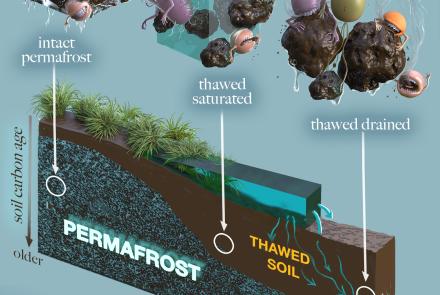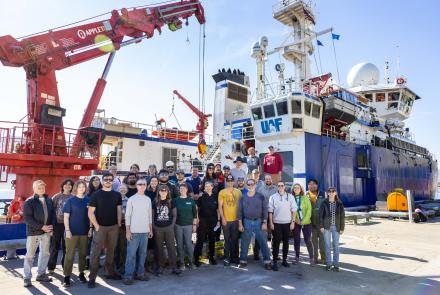An intriguing rock in the Alaska wilderness
NEAR THE MIDDLE FORK, CHANDALAR RIVER — Our knees pressed into crunchy lichen, three of us hunch around a rock the size of a postage stamp.
Peter Jenniskens, a meteor astronomer with the SETI (Search for Extraterrestrial Intelligence) Institute in Mountain View, California, is smiling. This rock is unusual: it was sitting on top of day-glow lichen and is dark as a charcoal briquette.
“I’m very excited by this top layer here,” Jenniskens says. “It might be a fusion crust.”
A fusion crust forms on a meteorite as it burns through the atmosphere. One may have fallen on this wilderness bench of spruce and dwarf birch after blasting down from space at 13 miles per second. Jenniskens is searching here on the chance that a blue pixel caught on Fairbanks Doppler radar last Feb. 26 might represent the fallout from a broken-up six-foot meteorite.
The tall, enthusiastic scientist is kneeling over a rock that may not be of this planet.
“It hasn’t sunk in yet,” he says to me and wilderness guide Garrett Jones. “This could be what I am looking for. I can tell you shortly. I have a magnifying glass to tell if that’s a fusion crust.”
He does not pull out his magnifier right away. Instead, he rocks back on his heels and contemplates the stone. He is savoring the moment of discovery, one he has felt before in the desert of Sudan and at Sutter’s Mill, California. In both places he found chunks of black rock that hissed to Earth from asteroid belts in space.
Feeling the excitement of this person who would volunteer for a mission to Mars even if he knew he would not return, I feel my heart speed a few beats. The smile on Garrett’s face hints that he feels it too.
After a minute of contemplation, Jenniskens utters a soft “wow.” He laughs and slaps his hands together. He then pulls a small sheet of aluminum foil from his backpack. He scoops the rock with it.
He holds the rock to a magnifying loupe cupped over his left eye. Garrett and I hold our breath. We have spent hours hiking over tundra and tussock in an honest search of the potential fallout zone. In what Jenniskens describes as a “high risk, high reward” endeavor, we very much hope for the payoff.
Peering through the loupe, Jennisken slumps his shoulders.
“It looks like a piece of sedimentary rock,” he says. “Basically a terrestrial conglomerate . . . The weight is right and it was on top of tundra. Oh, man, this is close.”
He sighs. Garrett and I share his disappointment at the near miss. To me it feels like your team loading the bases down a run in the ninth, then making the third out.
Jenniskens wraps the rock in foil and plucks some lichen. He also wraps that in foil. Even though the rock looks like no meteorite he has seen, he will bring it back to California and have another expert confirm that this rock came from the Earth.
He tucks the squares of foil into his backpack and stands, brushing lichen crumbs from his jeans. We start back toward our camp, two miles away on the middle fork of the Chandalar River. We are quiet except for when Garrett leads us into thick brush and yells to unseen bears we are looking for meteorites.
Jenniskens did not expect to find bits of meteorite on this trip, but he was hopeful. This trip deep to Alaska wilderness, so far out of his comfort zone, was something he felt compelled to do. Why?
The scientific reason is that this rock’s path through the atmosphere was tracked from space. A found meteorite allows researchers to backtrack it to where it came, which may help identify what type of rock is approaching when an asteroid on a similar orbit is hurtling towards Earth.
Another reason: the thrill of discovery. A space rock can deliver never-before-seen materials, even if just a small bit survives.
“I’ve been top-full of adrenaline for a few days,” Jenniskens says over an evening coffee at our camp in river willows. “I can completely understand the gold rush. The hope. The anticipation.”
He has seen meteorite rushes before. The event near Sutter’s Mill attracted hundreds of meteorite hunters who hoped to sell the rocks on eBay at twenty times the price of gold.
But he is not in the game to sell meteorites. He wants to know what came down. Satellite, infrasound networks and weather radar show that a six-foot asteroid broke up over Alaska, but not a single person reported seeing a flash or hearing a boom in late February.
“It still strikes me that nobody saw this thing, and this is the U.S.,” he says.
Jenniskens says he probably won’t come back to this remote country on the northern fringe of the boreal forest, but he would spend all summer searching if he could afford the expense of helicopters and guides. If not him, he hopes someone will contact him someday with news of either seeing or hearing the event. Or, even better, a miner or river traveler might show up at his office and plunk down a black rock from Alaska.
“We still don’t know what came in that night,” he said. “The mystery remains.”



